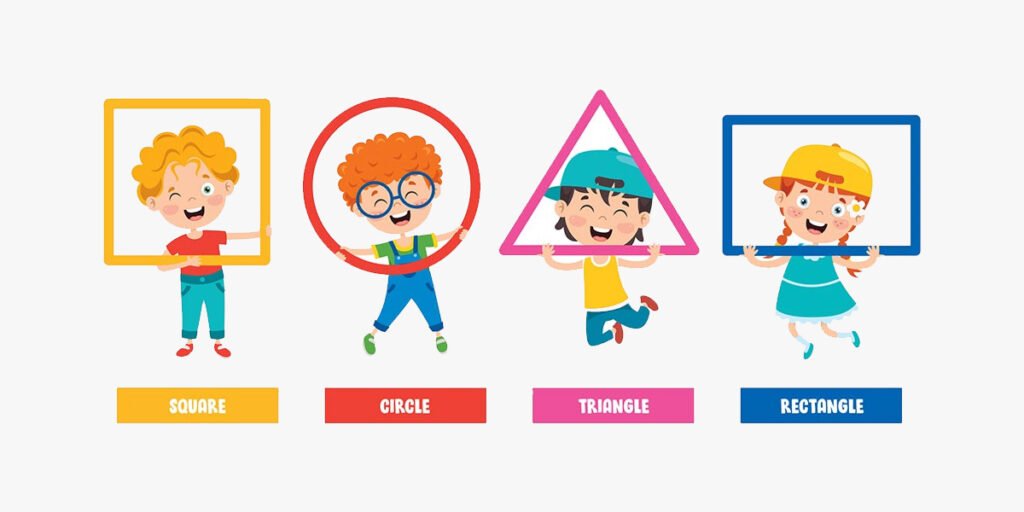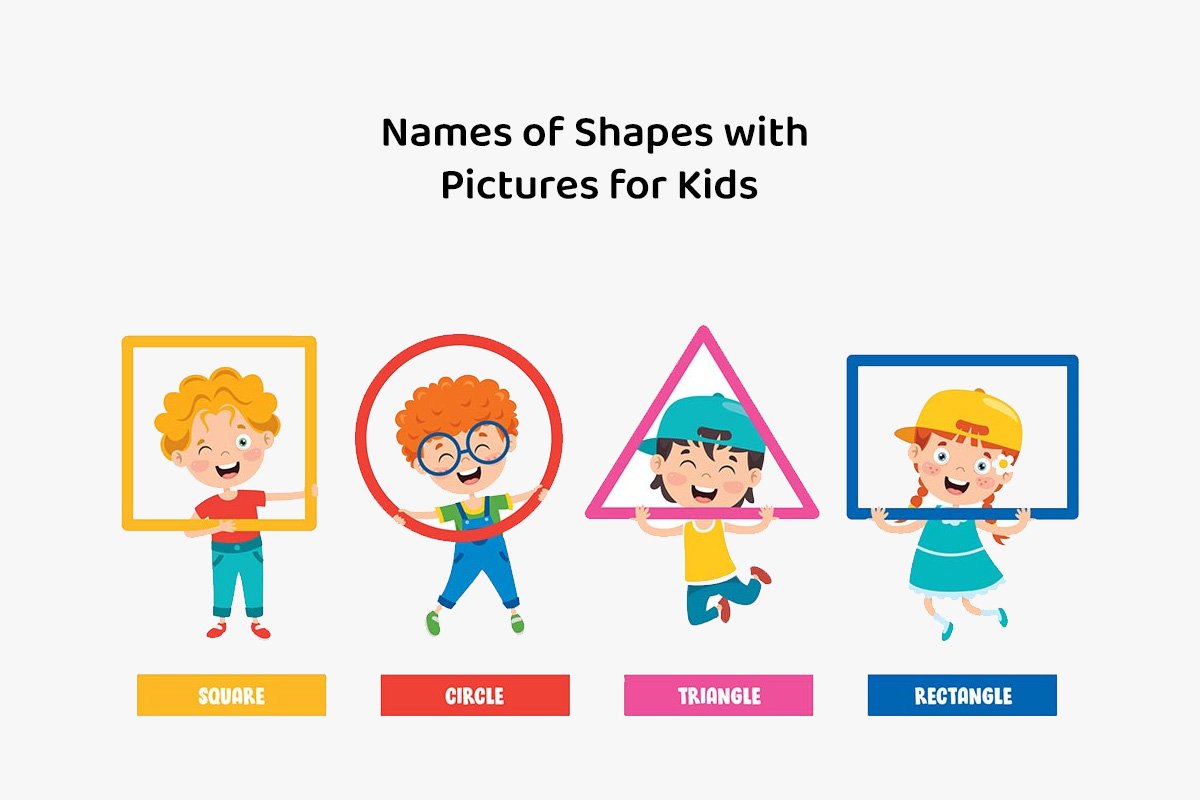Names of Shapes with Pictures for Kids
Shapes with Pictures for Kids

Importance of Learning Shapes
Learning shapes holds significant importance in early childhood development for several reasons:
Foundation for Math: Shapes serve as building blocks for geometry and spatial reasoning. Understanding shapes lays the groundwork for more complex mathematical concepts in later education.
Visual Discrimination: Recognizing shapes helps children differentiate between objects based on their form, size, and orientation, enhancing visual discrimination skills.
Language Development: Learning shapes introduces new vocabulary, encouraging children to articulate and describe the characteristics of various shapes, aiding language development.
Problem-Solving Skills: Identifying and manipulating shapes fosters problem-solving abilities. Children learn to analyze and categorize objects based on their shape, enhancing critical thinking.
Preparation for Everyday Skills: Knowledge of shapes is practical for daily tasks like understanding road signs, identifying objects, and comprehending spatial relationships in the environment.
Art and Creativity: Shapes are fundamental in art and design. Familiarity with shapes enables kids to express creativity through drawing, painting, and constructing objects.
Early STEM Learning: Introducing shapes early on can spark interest in STEM (Science, Technology, Engineering, and Mathematics) fields by laying the groundwork for understanding patterns, structures, and measurements.
Overall, learning shapes in early childhood is more than just identifying geometric forms. It contributes to cognitive development, problem-solving abilities, and provides a foundation for various academic disciplines and practical life skills.
List of Shape Names with Pictures
Shapes are fundamental for kids’ cognitive development. Here are some shapes along with their corresponding pictures that can be engaging and helpful for children. Here’s an outline covering basic and advanced shapes along with descriptions and real-world examples for each:
1. Basic Shapes
A. Circle

Description: A closed shape with all points equidistant from the center.
Real-world Examples: Clocks, wheels, coins.
B. Square

Description: A four-sided polygon with equal sides and right angles.
Real-world Examples: Windows, post-it notes, picture frames.
C. Triangle

Description: A three-sided polygon with straight sides.
Real-world Examples: Pizza slices, yield signs, rooftops.
D. Rectangle

Description: A four-sided polygon with opposite sides being equal and right angles.
Real-world Examples: Doors, books, tablets.
2. Advanced Shapes
A. Pentagon

Description: A five-sided polygon with five angles.
Real-world Examples: Home plate in baseball, pentagon-shaped buildings.
B. Hexagon

Description: A six-sided polygon with six angles.
Real-world Examples: Honeycomb cells, bolts or screws, some traffic signs.
C. Octagon

Description: An eight-sided polygon with eight angles.
Real-world Examples: Stop signs, some building structures, jewelry shapes.
D. Oval

Description: A shape resembling a stretched circle.
Real-world Examples: Eggs, footballs, leaves.
This breakdown with descriptions and examples can help kids better understand and identify these shapes in their surroundings, making learning both informative and enjoyable.
3D Shapes
- Sphere

Description: A round, three-dimensional object with all points on its surface equidistant from its center.
Real-world Examples: Balls, planets, oranges.
- Cube

Description: A six-faced solid figure with equal square sides and angles.
Real-world Examples: Dice, Rubik’s Cube, building blocks.
C. Cylinder

Description: A three-dimensional shape with two parallel circular bases connected by a curved surface.
Real-world Examples: Cans, tubes, some types of containers.
- Cone

Description: A three-dimensional shape with a circular base tapering to a point (apex).
Real-world Examples: Ice cream cones, traffic cones, party hats.
Unusual and Fun Shapes
- Star

Description: A shape with multiple pointed ends radiating from a center, resembling a star.
Real-world Examples: Celestial stars, starfish, some decorative designs.
- Heart

Description: A symbol representing affection or love, typically with two curved sections meeting at the bottom.
Real-world Examples: Heart-shaped candies, valentine cards, some fruits.
- Diamond

Description: A four-sided figure with two pairs of parallel sides, typically wider at the top and bottom.
Real-world Examples: Diamonds (gemstones), playing cards, kite shapes.
- Crescent

Description: A shape resembling a thin, curved moon or a boat with a curved bottom.
Real-world Examples: Crescent moon, croissants, some decorative motifs.
Introducing these 3D shapes and unusual/fun shapes alongside their real-world examples can make learning about geometry and spatial concepts more engaging and relatable for children.
Engaging Ways to Teach Shapes to Kids
Teaching shapes to kids can be fun and engaging! Here are some creative and interactive methods to make learning shapes enjoyable:
Shape Hunts: Go on a shape scavenger hunt around the house or outdoors. Encourage kids to find objects of specific shapes and identify them. Take pictures or collect items to create a shape collage later.
Shape Sorting Games: Use toys or cutouts of different shapes and sizes. Ask kids to sort them into different categories based on shapes, colors, or sizes. This helps in recognizing and categorizing shapes.
Arts and Crafts: Create art projects using shapes. Cut out shapes from colored paper and let kids create pictures or collages by arranging and sticking shapes together. They can make animals, cars, or houses using different shapes.
Building with Shapes: Use building blocks or construction toys like LEGO to build various shapes or structures. Encourage kids to replicate simple shapes or create more complex designs using these blocks.
Shape Puzzles: Provide shape puzzles or create DIY puzzles by cutting out shapes from cardboard and mixing them up. Kids can match shapes to complete the puzzles.
Storytime with Shapes: Incorporate shapes into storytelling. Use shapes to create characters or settings in a story. For instance, a circle can become the sun, and squares can be houses.
Outdoor Chalk Art: Take chalk outside and draw shapes on the sidewalk or driveway. Encourage kids to jump on or around the shapes as they identify them.
Interactive Apps and Games: Use educational apps or games designed for learning shapes. Many interactive apps engage kids through puzzles, quizzes, and shape-related activities.
Cooking with Shapes: Use cookie cutters or molds of different shapes to create snacks or sandwiches. This hands-on activity helps kids recognize shapes while having fun in the kitchen.
Music and Movement: Create songs or rhymes about shapes and encourage kids to dance or move in shapes (e.g., pretending to be triangles, circles, or squares).
By incorporating these activities into playtime and learning routines, children can develop a strong understanding of shapes while having a great time exploring and creating.
Conclusion
Learning shapes isn’t just about identifying geometric forms; it’s a fundamental step in a child’s cognitive development. Through engaging activities, hands-on experiences, and creative exploration, children not only recognize shapes but also develop critical skills like spatial awareness, problem-solving, and vocabulary expansion.
From scavenger hunts to arts and crafts, shape-based activities foster an enjoyable learning environment where kids can explore, create, and discover the world around them. These interactive methods make learning shapes a fun and memorable experience, laying a strong foundation for their educational journey.
By incorporating these engaging approaches, caregivers and educators can ignite curiosity, stimulate imagination, and instill a deeper understanding of shapes, setting the stage for broader learning and cognitive growth. Ultimately, making learning about shapes an exciting adventure enhances a child’s overall development and nurtures a love for learning.





Leave a Reply